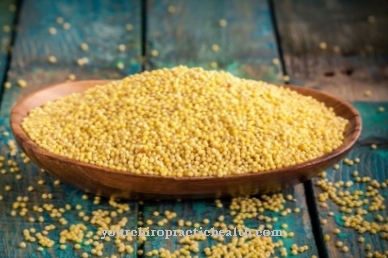After the first scientific description of the Service tree The plant was long forgotten in 1753 by the Swedish botanist Carl von Linné. After being named “Tree of the Year 2011” in Germany, many people became aware of the miracle fruit service tree. After all, the healing and tasty fruit of the "beautiful Else" has a lot to offer.
What you should know about the service tree

The service tree (lat. sorbus torminalis) belongs to the genus of whitebeam, which belongs to the rose family. The summer green tree of the Swiss pear is the largest rose family in the world and probably has its roots in the Caucasus.
For centuries it has been delighting carpenters with its hard, beautiful precious wood. Instrument makers in particular wanted the fine-grained wood because of its excellent polishability. The deciduous tree, which can live up to three hundred years, has maple-like leaves on its rounded, spherical crown. From April to June, the precious wood plant is adorned for up to 12 days with small, pure white flowers that are grouped into large umbels.
In late summer, the tree, which is up to 25 m high, produces fruits that are around one and a half centimeters in size. The color of the round to pear-shaped service tree is initially olive. When the fruit ripens after the first frost in October, the color changes to a red-brown dotted with light spots.
The service tree or also Adlitzberry, as it is called in Austria, is widespread in Central and Southern Europe, with an emphasis on the Balkans and France. Foothills of the distribution area can be found as far as Asia and North Africa. Usually the trees grow individually or in small groups in the middle of oak and beech forests. The preferred climate is warm and rather dry, which is why the service berries thrive particularly well on slopes facing south. Thanks to its good resistance, the Swiss pear tree is frost-resistant and also grows very well in the shade.
The soil for the service tree should be rich in nutrients and clay, which is why the occurrence on sandy or marshy soils that are oversaturated with water is almost impossible.
The fruits of the wild sparrow hawk tree are edible and initially have a bitter taste, which turns into sweet and sour with increasing ripeness. The delicious aroma is reminiscent of almonds and marzipan. The consistency of the Adlitzberry changes from hard to doughy to jelly-like. Since they become sweeter and softer as they ripen, it is important to catch them before the birds, which also consider the service tree a treat.
Importance to health
The fruit of the service tree has always been used to heal intestinal diseases, as the Latin name proves. Because the word torminalis comes from the expression tormina, which stands for stomach pain.
The administration of a wild service berry mixture against dysentery and against cholera was common practice in Europe in the Middle Ages. This is where the popular name "Ruhrbirne" or "Darmbirne" comes from. The Romans and the reformer Martin Luther already appreciated the chair-fixing and diuretic properties, who ordered them by letter from a friend for his sick wife. This positive effect on the stomach is due to the numerous tannins that are present in the service tree. Its astringent power supports all stomach and intestinal complaints that are due to an imbalance in the intestinal flora.
The vitamin C content and the considerable proportion of phytochemicals support the body's own immune system by strengthening it from within.
The cholesterol and uric acid lowering effect also shows a positive healing tendency in many diseases of civilization. Due to the high amount of vitamin C and polyphenols, the Swiss pear with the antioxidants it contains also counteracts skin aging and can therefore easily keep up with many other beauty boosters. Sometimes there is talk of a miraculous effect on headaches and migraines, which is due to the high tannin content and the associated astringent effect.
Ingredients & nutritional values
The service tree contains many tannins, including tannin. The contained significant amounts of flavonoids, fruit acids and vitamin C ensure a real energy boost in the immune system.
Intolerances & allergies
Since the service tree contains vegetable tannins, sensitive people with a tannin intolerance or allergy can react to the consumption of the fruit with vascular headaches or migraines. In addition, vomiting, nose irritation or upset stomach can occur.It should be noted that unripe fruits have a higher tannin content compared to fully ripened ones.
Shopping & kitchen tips
Since the service tree does not fall off by itself like other fruits, it has to be harvested individually by hand. After the painstaking fine-tuning, the berries are stored in a cool, dry place so as not to advance the ripening process. The short time when “the truffle among the berries” is available fresh on the market mostly takes place at the end of October and the beginning of November.
Due to the high pectin content, the unsaturated fruits can be cooked into jams and jellies without adding any additional thickening agents. Freezing the fresh berries enables their ingredients to be retained permanently. Soaking in sugary syrup also preserves the vitamins it contains. The service flower syrup, on the other hand, is prepared from the white flowers similar to the elderflower syrup. It unfolds its extraordinary taste, which is vaguely reminiscent of mead, best when added to champagne or sparkling wine.
The Swiss pear can be purchased dry all year round. Many health food stores and organic food retailers have the almost forgotten miracle berry in their regular range. The finely chopped dried vitamin bombs are mostly mixed with flavor carriers such as honey or chocolate or simply eaten in between as a vitamin-rich snack.
Preparation tips
The fresh service berries can be processed into delicious service fruit slices, a deliciously refreshing biscuit-based dessert. The addition of the fruit as a "certain extra" to pasta dishes, game or meat sauces is also very popular. This means that cranberries or cranberries, which are listed as tart and sour accents in many recipes, can be replaced and a completely new taste can be achieved.
As a contrast on a spicy cheese platter or with a chocolate fondue, the bitter taste of the wild sparrowhawk comes into its own. In Krems, Austria, Alitzberries are processed into chocolate together with nougat. Of course, the fruits can be made into jam or dried as a healthy addition to morning muesli. The most valuable use, however, can be found in the typical Lower Austrian noble brandy and in its Alsatian counterpart, the "Alisier". The fruity almond taste gives the roasted schnapps, which can cost up to € 300 per liter, a very special touch.



























